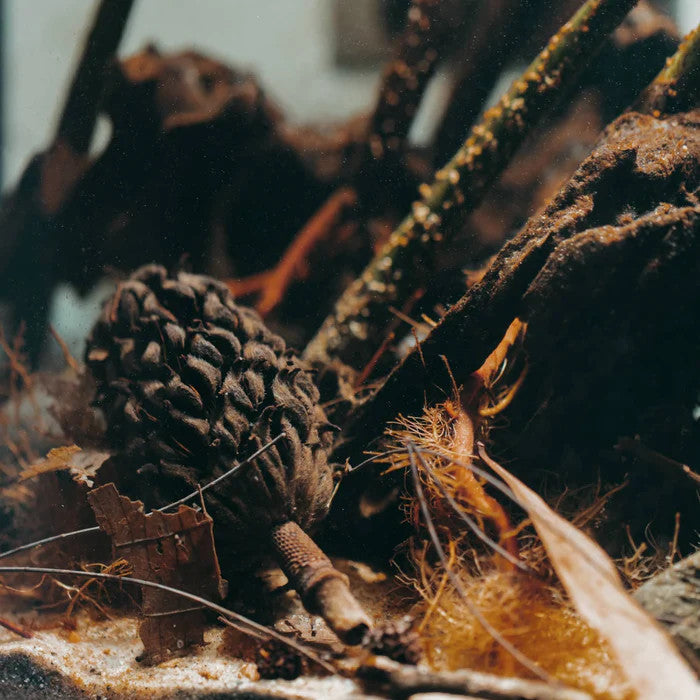Table of Contents
Casuarina cones may not be unfamiliar to Asian aquarium hobbyists, yet a little bit alien to the American fishkeepers. Act in a way similar to Almond leaves or Alder/ Birch cones, Casuarina cones are really worth your consideration due to many reasons.
What is Casuarina cone?
The pretty pineapple-like cones are cones from Casuarina equisetifolia or "Australian Pine Tree” which are widely found in many Asia regions. The allocation somewhat explains their less popularity to other aquarium hobbyists outside that area.
Casuarina cones are relatively small (about half an inch to 1 inch in length). Yet, if compared with Alder or Birch cones, it seems to be much larger. The botanical has a great deal of benefits to the aquarium community mainly in terms of altering water chemistry and serving aesthetic purposes.

(Image of a bundle of Casuarina cones)
How does the aquarium community benefit from Casuarina cones?
Casuarina cones, much like Alder or Birch cones, are best known for the impressive capacity of releasing tannin and creating a ‘blackwater’ atmosphere in aquariums with just a small number of botanicals. Moreover, the cones show superiority over Alder and Birch cones in both aspects of staying intact and producing tannins for a longer time. For many skilled aquarists, this botanical is the preferable and ‘organic’ solution, which not only assists them in monitoring the water parameters in their tanks, but also allows them to freely design any desired blackwater aquascape by making use of the tannin released from Casuarina cones or even the cones themselves.

(Image of a blackwater aquarium decorated with Casuarina cones)
Besides, the texture of Casuarina cones makes them the suitable place for biofilm to dwell in and establish, the very good and favorite food source of shrimp. Hence, Casuarina cones are sometimes recommended for shrimp-keepers. It has not mentioned that in case those cones are large enough, they could even be the perfect refuges for baby shrimp when they feel threatened.
Lowering pH levels is another benefit of Casuarina cones but its effect is not as significant as Alder, or even Birch (especially if your tank water is RO/RI). For your ease of imagination, let’s take Alder as an example. According to a study, a bundle of one to six Alder cones could cause the pH levels of 10 ounces of tap water from eight down to six and a half after about two weeks. With the similar conditions applied to Casuarina cones, the result will be less impressive. Nonetheless, as we’ve discussed above, the big plus of Casuarina cones is that they will take a longer time to break down and stop producing tannin. Therefore, the landscape effect could last longer and the replacement of new cones could less happen.
How to use Casuarina cones in aquariums?
This is pretty straightforward, either throw them directly into the aquarium or put them in the filter/ filter media where the water flows go through are both accepted. The former may kill two birds with one stone (producing tannin whereas allowing Casuarina cones to act as a décor) if the aquarists are clever in aquascaping concepts. However, those who are not much fond of the shape of these cones often prefer the latter. The idea of letting water flow through a bundle of cones will stimulate the release of tannin, shortening the period of yellowing tank water.
Whichever method you favor, remember to rinse the cones in warm water before introducing them to your tank. This helps remove any potential harm attached to the cones which may cause bad effects to your tank community when introduced to. Even if you buy Casuarina cones from reliable sources, this step is still recommended as no store guarantees their botanicals totally free from foreign particles (for example, dust, dirt, bacteria).
In case you want to stimulate the tannin-production, you could soak the cones in water for about 15-20 minutes before putting them in the tank to achieve the best result.
On the other hand, if you don’t want too much yellow or brown effect in your tank, you can boil Casuarina cones a little bit to let them release a large amount of tannin before they are active in your tank.
When employing these botanicals to impact water chemistry, you have to keep track of all other elements in your tank to make sure they are well monitored. Casuarina cones are worth a try; however, we highly recommend you to go for a small number of the cones (7 cones for 10 gallons of water) at the beginning to see whether the outcome meets your expectation.
At Splashy Fish Store, we supply a wide range of Casuarina cones which come from reliable sources. We care about the quality and strive to provide you the best we can. Visit our store to find what surprise is waiting for you.



























